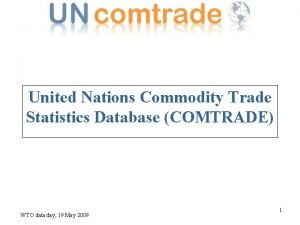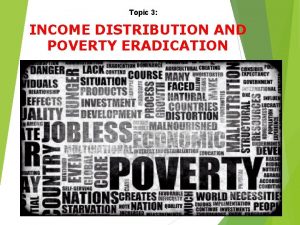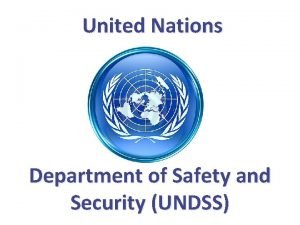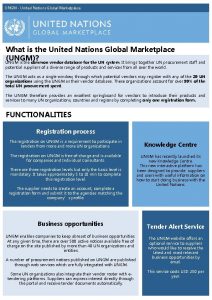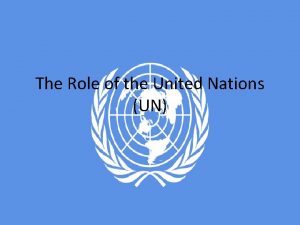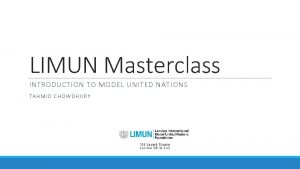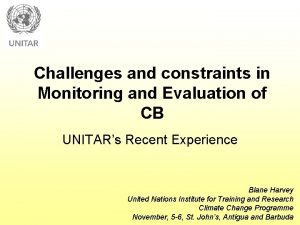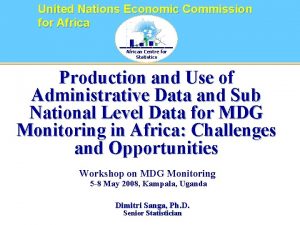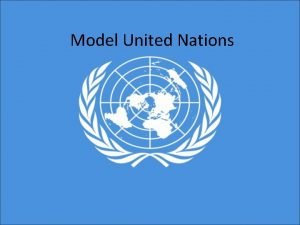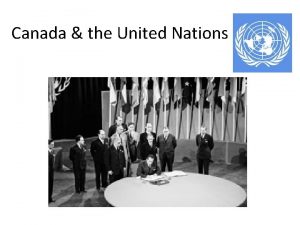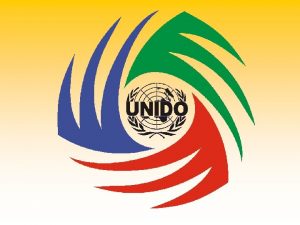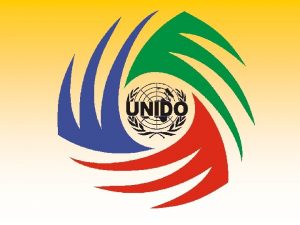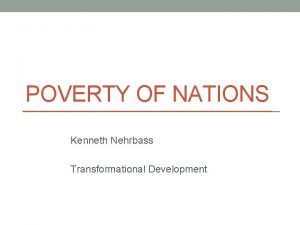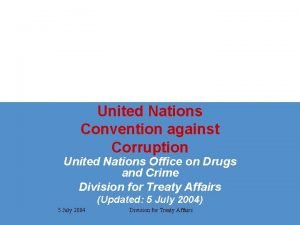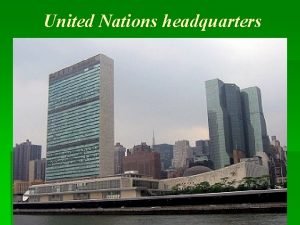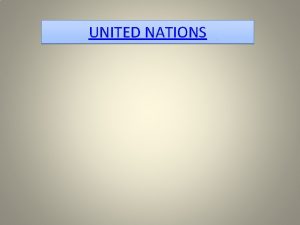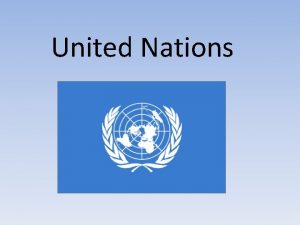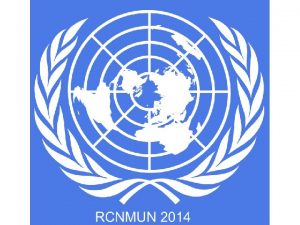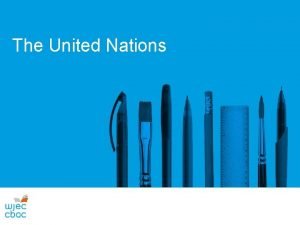United Nations Development Programme Trade Growth Poverty Partnerships


















- Slides: 18

United Nations Development Programme Trade, Growth, Poverty Partnerships To Fight Poverty and Human reduction Development Recent Developments, Conceptual Issues, Some Empirical Evidence South Centre Panel, WTO Symposium, Geneva, 21 April 2005, Presentation by David Luke, Coordinator, UNDP Trade and Human Development Unit, Geneva David. Luke@undp. org 10/7/2020 This presentation draws upon ongoing work by Kamal Malhotra to elaborate the key messages of the UNDP co-sponsored publication, Making Global Trade Work for People of which he was the lead author. The views expressed here do not necessarily represent UNDP or UN policy. 1

Overview n n n n 10/7/2020 Summary of recent issues as regards MDG 8 Linking HD and trade Growth, poverty and HD Trade liberalization and growth literature China and India, LDCs, East Asia Conclusions 2

Recent issues as regards MDG 8 n n 10/7/2020 In Larger Freedoms Report Sachs Report Unleashing Entrepreneurship Report Each recognize potential role of trade in PR and HD but over-emphasis on trade liberalization, export growth and market access as key drivers 3

Linking HD and trade Ø Trade can be a powerful source of economic growth. But while broadly based economic growth is necessary for human development, it is not enough. 10/7/2020 • Human development also requires enlarging people’s choices and opportunities—especially poor people’s. • Liberalizing trade does not ensure poverty reduction or human development, nor does it guarantee immediate economic growth. [Rather, this is largely determined by internal and external institutional and social pre-conditions. ] • The nature of resource allocation and social inclusion — especially for women and those participating in the informal sector — are important determinants of growth leading to poverty reduction and human development. 4

Growth, poverty and HD • Trade and growth should be seen as means to development rather than ends in themselves. • Growth can be jobless, rather than job creating; ruthless, rather than poverty reducing; voiceless, rather than participatory; rootless, rather than culturally enshrined; and futureless, rather than environmentally friendly. • Growth that is jobless, ruthless, voiceless, rootless and futureless is not conducive to poverty reduction or human development. 10/7/2020 5

Growth, poverty and HD n Nevertheless, economic growth can contribute to poverty reduction and human development in two ways: Employment-led growth raises household income — which can reduce poverty and lead to increased human capabilities Growth can increase government revenue — which can reduce poverty and benefit human development if used to pursue policies aimed at reducing income and asset inequality and health and education enhancement 10/7/2020 6

Trade liberalization and growth • International trade can expand markets, facilitate competition and disseminate knowledge, creating opportunities for growth, poverty reduction and human development. • Trade can also raise productivity and increase exposure to new technologies, which often spurs growth. • Nevertheless, cross-national comparisons reveal no systematic relationship between countries’ average levels of tariffs and non-tariff barriers and their subsequent economic growth. 10/7/2020 7

• Most recently in Asia, Viet Nam is a good example which illustrates that trade, esp. import liberalization is not a prerequisite for sustained economic growth (the Republic of Korea, PR China and India are others) • Since the mid-1980 s Viet Nam, which is not yet a WTO member, has taken a gradual approach to economic reform, following a two-track programme that has the following characteristics: 10/7/2020 8

n n n n 10/7/2020 Significant state trading Maintenance of important import monopolies Retention of quantitative restrictions and high tariffs (30 -50%) on agricultural and industrial imports Yet Viet Nam has: Achieved GDP growth of more than 6% per annum for a sustained period Sharply reduced poverty Expanded trade Attracted considerable foreign investment And (despite high trade barriers) is rapidly integrating with the global economy 9

Trade liberalization and growth literature • The best-known literature that claims trade liberalization promotes higher growth—including the Sachs-Warner (1995) and Dollar (1992) studies—are flawed in important respects. • The approaches used for classifying developing countries as ‘open’ or ‘closed’ have the following widespread problems: Policy outcomes such as trade as percent of GDP (which are often not in governments’ control) are used as measures instead of actual trade policies (e. g. tariff reduction). The measurements are based on rates of growth in trade volumes, which are the outcome of many things, including an economy’s overall performance. Many such measures of openness are actually correlated with alternative explanatory variables such as: macroeconomic instability, poor institutions, and geographic location. 10/7/2020 10

Trade liberalization and growth literature n 10/7/2020 Once these problems are corrected, the only systematic relationship found is that countries dismantle trade barriers as they get richer. The experiences of industrial and successful developing countries provide the following additional lessons: Integration with the world economy is an outcome of growth and development, not a prerequisite. Institutional innovations — many of them unorthodox and requiring considerable domestic policy space and flexibility — have been crucial for successful development strategies and outcomes. 11

China and India Chinese and Indian trade restrictions are amongst the highest in the world. 10/7/2020 • Increase in China’s growth started in the late 70 s. Trade liberalisation started only when the growth rate increased substantially - in the second half of the 80 s and the 90 s. • India’s growth rate increased substantially in the early 80 s. Trade reform started in 1991 – 1993. Tariffs were higher in the high growth period of the 80 s than in the low growth 1970 s. • It is therefore not obvious that • Further liberalisation is in all countries’ interests • That the world requires a set of global rules, universally applied, that promote greater freedom for global market actors • The Indian and Chinese experiences suggest that a gradual, sequenced approach is beneficial, and that import and trade liberalisation are not necessarily the highest development priority. 12

LDCs 10/7/2020 • LDCs have been told that trade liberalization reduces poverty, but their experiences have not proved this: • Poverty is increasing in the LDCs with both open and closed trade regimes. But between these extremes, poverty is increasing in countries that have liberalized trade more. • Conclusion 1: trade liberalization does not necessarily reduce poverty. • LDCs have also been told to export their way out of poverty. GDP declined or stagnated in 8 out of 22 LDCs with increased exports. In 10 of these countries, poverty increased. 14 with rising GDP saw poverty fall. • Conclusion 2: Unless there is sustained growth, increasing exports does not reduce poverty. 13

East Asia 10/7/2020 • The Asian Tigers are often presented as examples of countries that predominantly relied on export-led growth. This was only one, and not the most important of their strategies. Other strategies used included: • Protection of the domestic market – most of their trade liberalisation occurred only after high growth was established in the 1980 s • Government supports to local investors through: credit subsidies; tax incentives, education promotion; generous export subsidies; duty-free excess to access and capital goods; extension of credit to large businesses at negative real interest rates. E. g. . In Korea, the state bailed out entrepreneurs investing in ‘desirable’ activities if these became non-viable. 14

East Asia (2) 10/7/2020 • Public enterprises also enhanced the profitability of private investment by ensuring that key inputs were available for private producers e. g. . through a large share of manufacturing output • Encouraged firms to reverse engineer foreignpatented products • 5) Imposed TRIMS requirements on foreign investors e. g. . export-import balance requirements; domestic content requirements. 15

Conclusions 10/7/2020 • The only systematic relationship between countries’ economic growth and their trade barriers is that they dismantle trade restrictions as they get richer. Economic integration is an outcome, not a prerequisite to growth and development. • Institutional innovations – many unorthodox and requiring policy space – are crucial for success. 16

A Trade Regime Friendly to Human Development n n n 10/7/2020 This trade regime can start with the following: Human development assessments – research, calculation of costs, and analysis of human development implications of multilateral, regional and bilateral agreements before they are endorsed. Diversity in development strategies – A trade regime manages diversity, rather than one that unifies and harmonizes national policies. Asymmetric rules – One-size-fits all does not work. Asymmetry needs to be more systematically built into the regime as a starting point for rules. The principles of reciprocity and non-discrimination should be linked to the economic capacity of countries and restricted to groups of countries at similar levels of human development. 17

Thank you 10/7/2020 18
 Un commodity trade statistics database
Un commodity trade statistics database Distinguish between absolute poverty and relative poverty
Distinguish between absolute poverty and relative poverty Accenture development partners
Accenture development partners Product development partnerships
Product development partnerships United nations
United nations Un department of safety and security
Un department of safety and security What is ungm
What is ungm Six main organs of the united nations
Six main organs of the united nations Role of united nations
Role of united nations Ethics and integrity at the united nations
Ethics and integrity at the united nations Introduction to model united nations
Introduction to model united nations Monitoring and evaluation challenges
Monitoring and evaluation challenges United nations zambia
United nations zambia United nations
United nations United nations
United nations Model united nations
Model united nations The agency sponsored by the united nations that compiles
The agency sponsored by the united nations that compiles Frsc vision and mission
Frsc vision and mission Christian saunders united nations
Christian saunders united nations
